A Contribution to a UHS-Based Seismic Risk Assessment in Croatia—A Case Study for the City of Osijek
Abstract
1. Introduction
2. Proposed Methodology
3. The Seismic Hazard Evaluation
4. Exposure
4.1. Review of Existing Building Taxonomies
4.2. Predominant Building Typologies for the City of Osijek
- -
- gathering the data from the archives of some public institutions or companies, such as hospitals, schools, kindergartens, etc.
- -
- going to the site and analyzing the buildings.
- -
- unreinforced masonry structures (URM), flexible floors (old bricks)
- -
- unreinforced masonry structures, rigid floors
- -
- confined masonry structures
- -
- reinforced-concrete frame structures (RC)
- -
- shear walls, built without taking into consideration earthquake-resistant design.
5. Seismic Vulnerability Assessment for Civil Engineering Structures
5.1. Existing Seismic Vulnerability Assessment Methods
- -
- vulnerability as one of the main factors in the seismic risk analysis,
- -
- vulnerability as a major factor in the development of earthquake scenarios,
- -
- the basis for establishing a risk reduction strategy for buildings or the classification of risk elements,
- -
- base data for the creation of intensity scales (e.g., EMS-98 scale [40], which refers explicitly to seismic exposure).
5.2. Experiences Obtained by Provided Seismic Vulnerability Assessment Methods in Croatia
6. Results
6.1. Selected Characteristics of Buildings for the Database
- -
- number of stories
- -
- material type
- -
- lateral load resistant type
- -
- elevation irregularity
- -
- plan irregularity
- -
- ground type
- -
- changes in vertical strength and/or stiffness (e.g., soft stories)
- -
- short column (applicable to RC frame structures only).
- -
- structural system
- -
- year of construction
- -
- state of preservation
- -
- the regularity of the floor plan
- -
- regularity along with the height
- -
- number of stories
- -
- story height and total building height
- -
- the material used for the construction of the walls and the type of the floor structure
- -
- position within the block
- -
- building size
- -
- floor area and gross floor area of the building
- -
- ground type
- -
- purpose of the building.
- -
- cadastral parcel number
- -
- street name and house number.
6.2. Provided Seismic Vulnerability Assessments Based on the Selected Building Characteristics
- SPI = 0–10 indicates low priority
- SPI = 10–20 indicates a medium priority
- SPI = 20–30 indicates a high priority
- SPI > 30 potentially hazardous
7. Conclusions
Author Contributions
Funding
Conflicts of Interest
References
- Nikoo, M.; Ramezani, F.; Hadzima-Nyarko, M.; Nyarko, E.K.; Nikoo, M. Flood-routing modeling with neural network optimized by social-based algorithm. Nat. Hazards 2016, 82, 1–24. [Google Scholar] [CrossRef]
- Alizadeh, M.; Alizadeh, E.; Asadollahpour Kotenaee, S.; Shahabi, H.; Beiranvand Pour, A.; Panahi, M.; Bin Ahmad, B.; Saro, L. Social Vulnerability Assessment Using Artificial Neural Network (ANN) Model for Earthquake Hazard in Tabriz City, Iran. Sustainability 2018, 10, 3376. [Google Scholar] [CrossRef]
- Zhai, Y.; Chen, S.; Ouyang, Q. GIS-Based Seismic Hazard Prediction System for Urban Earthquake Disaster Prevention Planning. Sustainability 2019, 11, 2620. [Google Scholar] [CrossRef]
- Akamatsu, T.; Yamamoto, K. Suitability Analysis for the Emergency Shelters Allocation after an Earthquake in Japan. Geosciences 2019, 9, 336. [Google Scholar] [CrossRef]
- Ajmar, A.; Annunziato, A.; Boccardo, P.; Giulio Tonolo, F.; Wania, A. Tsunami Modeling and Satellite-Based Emergency Mapping: Workflow Integration Opportunities. Geosciences 2019, 9, 314. [Google Scholar] [CrossRef]
- Chian, S.C.; Wilkinson, S.M.; Whittle, J.K.; Mulyani, R.; Alarcon, J.E.; Pomonis, A.; Saito, K.; Fraser, S.; Goda, K.; Macabuag, J.; et al. Lessons Learnt From the 2009 Padang Indonesia, 2011 Tohoku ¯Japan and 2016 Muisne Ecuador Earthquakes. Front. Built Environ. 2019, 5, 73. [Google Scholar] [CrossRef]
- Işık, E. Consistency of the rapid assessment method for reinforced concrete buildings. Earthq. Struct. 2016, 11, 873–885. [Google Scholar] [CrossRef]
- Hadzima-Nyarko, M.; Pavić, G.; Lešić, M. Seismic vulnerability of old confined masonry buildings in Osijek, Croatia. Earthq. Struct. 2016, 11, 629–648. [Google Scholar] [CrossRef]
- Bilgin, H.; Huta, E. Earthquake performance assessment of low and mid-rise buildings: Emphasis on URM buildings in Albania. Earthq. Struct. 2018, 14, 599–614. [Google Scholar]
- Banica, A.; Rosu, L.; Muntele, I.; Grozavu, A. Towards Urban Resilience: A Multi-Criteria Analysis of Seismic Vulnerability in Iasi City (Romania). Sustainability 2017, 9, 270. [Google Scholar] [CrossRef]
- Chieffo, N.; Formisano, A. Geo-Hazard-Based Approach for the Estimation of Seismic Vulnerability and Damage Scenarios of the Old City of Senerchia (Avellino, Italy). Geosciences 2019, 9, 59. [Google Scholar] [CrossRef]
- Aničić, D. Forecast of damage to the housing stock and the number of victims of a possible future earthquake in Zagreb (in Croatian). Civil. Zaštit. 1992, 1, 135–143. [Google Scholar]
- Herak, M.; Herak, D.; Markušić, S. Revision of the earthquake catalogue and seismicity of Croatia. 1908–1992. Terra Nova 1996, 8, 86–94. [Google Scholar] [CrossRef]
- Herak, D.; Herak, M.; Tomljenović, B. Seismicity and focal mechanisms in North-Western Croatia. Tectonophysics 2009, 465, 212–220. [Google Scholar] [CrossRef]
- Markušić, S.; Gülerce, Z.; Kuka, N.; Duni, L.; Ivančić, I.; Radovanović, S.; Glavatović, B.; Milutinović, Z.; Akkar, S.; Kovačević, S.; et al. An Updated and Unified Earthquake Catalogue for the Western Balkan Region. B Earthq. Eng. 2016, 14, 321–343. [Google Scholar] [CrossRef]
- Markušić, S.; Herak, M. Seismic Zoning of Croatia. Nat. Hazards 1999, 18, 269–285. [Google Scholar] [CrossRef]
- Official Gazette of SFRY. Temporary Technical Regulations for Construction in Seismic Areas; SFRY Official Gazette No. 39/64; Newspaper-publishing institution “Official Gazette of SFRY”: Belgrade, SFRY, 1964.
- Official Gazette of SFRY. Book of Rules on Technical Norms for Construction of High-Rise Buildings in Seismic Regions; Official Gazette of SFRY No. 31/81, Addendum No. 49/82; Newspaper-publishing institution “Official Gazette of SFRY”: Belgrade, SFRY, 1982.
- Official Gazette of SFRY. Book of Rules on Technical Norms for Construction of High-Rise Buildings in seismic Regions; Official Gazette of SFRY No. 31/81, Addendums No. 49/82, 29/83, 21/88, 52/90; Newspaper-publishing institution “Official Gazette of SFRY”: Belgrade, SFRY, 1990.
- Herak, M.; Allegretti, I.; Herak, D.; Ivančić, I.; Kuk, V.; Marić, K.; Markušić, S.; Sović, I. Republic of Croatia, Map of Seismic Areas (In Croatian). 2011. Available online: http://seizkarta.gfz.hr (accessed on 15 November 2019).
- CEN: Eurocode 8. Design of Structures for Earthquake Resistance—Part 1: General Rules, Seismic Actions and Rules for Buildings; Comité Européen de normalization: Brussels, Belgium, 2004. [Google Scholar]
- Hrvatski Zavod za Norme: HRN EN 1998-1:2011/NA:2011. Eurocode 8: Design of Structures for Earthquake Resistance—Part 1: General Rules, Seismic Actions and Rules for Buildings—National Annex; Hrvatski Zavod za Norme: Zagreb, Croatia, 2011. [Google Scholar]
- Trifunac, M.D.; Lee, V.W.; Živčić, M.; Manić, M.I. On the correlation of Mercalli-Cancani-Sieberg intensity scale in Yugoslavia with the peaks of recorded strong earthquake ground motion. Eur. Earthq. Eng. 1991, 5, 27–33. [Google Scholar]
- Bulajić, B.Đ.; Manić, M.I.; Lađinović, Đ. Effects of shallow and deep geology on seismic hazard estimates—A case study of pseudo-acceleration response spectra for the north-western Balkans. Nat. Hazards 2013, 69, 573–588. [Google Scholar] [CrossRef]
- Lee, V.W.; Manić, M.I.; Bulajić, B.Đ.; Herak, D.; Herak, M.; Trifunac, M.D. Microzonation of Banja Luka for performance-based earthquake-resistant design. Soil Dyn. Earthq. Eng. 2015, 78, 71–88. [Google Scholar] [CrossRef]
- Manić, M.I.; Bulajić, B.Ð.; Trifunac, M.D. A note on peak accelerations computed from sliding of objects during the 1969 Banja Luka earthquakes in former Yugoslavia. Soil Dyn. Earthq. Eng. 2015, 77, 164–176. [Google Scholar] [CrossRef]
- Lee, V.W.; Trifunac, M.D.; Bulajić, B.Đ.; Manić, M.I.; Herak, D.; Herak, M.; Dimov, G. Seismic microzoning in Skopje, Macedonia. Soil Dyn. Earthq. Eng. 2017, 98, 166–182. [Google Scholar] [CrossRef]
- Lee, V.W.; Trifunac, M.D.; Bulajić, B.Đ.; Manić, M.I.; Herak, D.; Herak, M.; Dimov, G.; Gičev, V. Seismic microzoning of Štip in Macedonia. Soil Dyn. Earthq. Eng. 2017, 98, 54–66. [Google Scholar] [CrossRef]
- Lee, V.W.; Trifunac, M.D.; Bulajić, B.Đ.; Manić, M.I.; Herak, D.; Herak, M. Seismic microzoning of Belgrade. Soil Dyn. Earthq. Eng. 2017, 97, 395–412. [Google Scholar] [CrossRef]
- Bulajić, B.Đ.; Bajić, S.; Stojnić, N. The effects of geological surroundings on earthquake-induced snow avalanche prone areas in the Kopaonik region. Cold Reg. Sci. Technol. 2018, 149, 29–45. [Google Scholar] [CrossRef]
- Trifunac, M.D.; Brady, A.G. On the Correlation of Seismic Intensity Scales with the Peaks of Recorded Strong Ground Motion. B Seismol. Soc. Am. 1975, 65, 139–162. [Google Scholar]
- Seed, H.B.; Idriss, I.M.; Kiefer, F.W. Characteristics of Rock Motions during Earthquakes, Earthquake Engineering Research Center; Report No. EERC 68-5, September 1968; College of Engineering, University of California: Berkeley, CA, USA, 1968. [Google Scholar]
- Lee, V.W.; Trifunac, M.D.; Bulajić, B.Đ.; Manić, M.I. Preliminary empirical scaling of pseudo relative velocity spectra in Serbia from the Vrancea earthquakes. Soil Dyn. Earthq. Eng. 2016, 86, 41–54. [Google Scholar] [CrossRef]
- Lee, V.W.; Trifunac, M.D.; Bulajić, B.Đ.; Manić, M.I. A preliminary empirical model for frequency-dependent attenuation of Fourier amplitude spectra in Serbia from the Vrancea earthquakes. Soil Dyn. Earthq. Eng. 2016, 83, 167–179. [Google Scholar] [CrossRef]
- Todorovska, M.I.; Gupta, I.D.; Gupta, V.K.; Lee, V.W.; Trifunac, M.D. Selected Topics in Probabilistic Seismic Hazard Analysis; Dept. of Civil Eng. Report No. CE 95-08; Univ. of Southern California: Los Angeles, CA, USA, 1995. [Google Scholar]
- Pittore, M.; Haas, M.; Megalooikonomou, K.G. Risk-Oriented, Bottom-Up Modeling of Building Portfolios with Faceted Taxonomies. Front. Built. Environ. 2018, 4, 41. [Google Scholar] [CrossRef]
- Jaiswal, K.; Wald, D.; Porter, K. A global building inventory for earthquake loss estimation and risk management. Earthq. Spect. 2010, 26, 731–748. [Google Scholar] [CrossRef]
- Kircher, C.A.; Whitman, R.V.; Holmes, W.T. HAZUS earthquake loss estimation methods. Nat. Hazards Rev. 2006, 7, 45–59. [Google Scholar] [CrossRef]
- Lang, D.H.; Molina, S.; Crempien, J.; Erduran, E. Earthquake Risk Reduction in Guatemala, El Salvador, and Nicaragua with Regional Cooperation to Honduras, Costa Rica, and Panama: Mapping of Typical Buildings; NORSAR: Kjeller, Norway, 2009. [Google Scholar]
- European Macroseismic Scale (EMS-98); Grünthal, G.M.; Roger, M.W.; Schwarz, J.; Stucchi, M. (Eds.) Cahiers du Centre Européen de Géodynamique et de Séismologie; European Centre for Geodynamics and Seismology: Walferdange, Luxembourg, 1998; Volume 15. [Google Scholar]
- Tyagunov, S.; Stempniewski, L.; Grünthal, G.; Wahlström, R.; Zschau, J. Vulnerability and risk assessment for earthquake-prone cities. In Proceedings of the 13th World Conference on Earthquake Engineering (13 WCEE), Vancouver, BC, Canada, 1–6 August 2004; pp. 1–6. [Google Scholar]
- Abrahamczyk, L.; Schwarz, J.; Langhammer, T.; Genes, M.C.; BikŸe, M.; KaŸin, S. Seismic risk assessment and mitigation in the Antakya-Maras region (SERAMAR): Empirical studies on the basis of EMS-98. Earthq. Spect. 2013, 29, 683–704. [Google Scholar] [CrossRef]
- Stone, H. Exposure and Vulnerability for Seismic Risk Evaluations. Ph.D. Thesis, Department of Civil, Environmental, and Geomatic Engineering, University College London, London, UK, 2017. [Google Scholar]
- NERA (Network of European Research Infrastructures for Earthquake Risk Assessment and Mitigation). Report D7.2 State of the Knowledge of Building Inventory Data in Europe, EUCENTRE; NERA: White Plains, NY, USA, 2011. [Google Scholar]
- Croatian Bureau of Statistics. Census of Population, Households and Dwellings 2011, Population by Citizenship, Ethnicity, Religion and Mother Tongue; Statistical Reports; Croatian Bureau of Statistics: Zagreb, Croatia, 2013. [Google Scholar]
- Kalman Šipoš, T.; Hadzima-Nyarko, M. Seismic risk of Croatian cities based on building’s vulnerability. Tehnicki Vjesnik 2018, 25, 1088–1094. [Google Scholar]
- Technical Regulation for Concrete Structures (NN 101/05); Newspaper-publishing institution “Official Gazette”: Zagreb, Croatia, 2005.
- Pavić, G.; Bulajić, B.; Hadzima-Nyarko, M. The Vulnerability of Buildings from the Osijek Database. Front. Built Environ. 2019, 5, 66. [Google Scholar] [CrossRef]
- Sandi, H.; Pomonis, A.; Francis, S.; Georgescu, E.S.; Mohindra, R.; Borcia, J.S. Seismic Vulnerability Assessment. Methodological Elements and Applications to the Case of Romania. In Proceedings of the International Symposium on Strong Vrancea Earthquakes and Risk Mitigation, Bucharest, Romania, 4–6 October 2007. [Google Scholar]
- Porter, K.A. Seismic Vulnerability. In Earthquake Engineering Handbook; Chen, W.F., Scawthorn, C., Eds.; CRC Press LLC.: Boca Raton, FL, USA, 2003. [Google Scholar]
- Rossetto, T.; Elnashai, A. A new analytical procedure for the derivation of displacement-based vulnerability curves for populations of RC structures. Eng. Struct. 2005, 27, 397–409. [Google Scholar] [CrossRef]
- Kwon, O.-S.; Elnashai, A. The effect of material and ground motion uncertainty on the seismic vulnerability curves of RC structure. Eng. Struct. 2006, 28, 289–303. [Google Scholar] [CrossRef]
- Whitman, R.V.; Reed, J.W.; Hong, S.T. Earthquake Damage Probability Matrices. In Proceedings of the Fifth World Conference on Earthquake Engineering, International Association for Earthquake Engineering, Rome, Italy, 25–29 June 1973; pp. 2531–2540. [Google Scholar]
- Braga, F.; Dolce, M.; Liberatore, D. A Statistical Study on Damaged Buildings and an Ensuing Review of the MSK-76 Scale. In Proceedings of the Seventh European Conference on Earthquake Engineering, Athens, Greece, 20–25 September 1982. [Google Scholar]
- Shiga, T.; Shibata, A.; Takahashi, T. Earthquake Damage and the Amount of Walls in Reinforced Concrete Buildings; Tobuku District Symposium: Tokyo, Japan, 1968. [Google Scholar]
- Benedetti, D.; Petrini, V. Sulla Vulnerabilità Di Edifici in Muratura: Proposta Di Un Metodo Di Valutazione. L’industria delle Costruzioni 1984, 149, 66–74. [Google Scholar]
- Antičević, A.; Hadzima-Nyarko, M.; Rabi, A. Seismic vulnerability of kindergarten buildings in the city of Osijek. In Proceedings of the 4th Conference—International Scientific Symposium, Economy of Eastern Croatia-Vision and Development, Osijek, Croatia, 21–23 May 2015. [Google Scholar]
- Ivandić, N.; Hadzima-Nyarko, M.; Štefić, T. Seismic vulnerability of primary schools in the city Osijek. In Proceedings of the 4th Conference—International Scientific Symposium, Economy of Eastern Croatia-Vision and Development, Osijek, Croatia, 21–23 May 2015. [Google Scholar]
- Hadzima-Nyarko, M.; Lešić, M.; Morić, D. Seismic Vulnerability Assessment for Residential Buildings in Osijek, Croatia. In Proceedings of the 16th World Conference of Earthquake Engineering, Santiago, Chile, 9–13 January 2017. [Google Scholar]
- Galista, M.; Hadzima-Nyarko, M. Assessing seismic risk in Retfala Nova. Electron. J. Faculty Civil Eng. 2015, 6, 50–61. [Google Scholar]
- Hadzima-Nyarko, M.; Nikić, D.; Pavić, G. Seismic Vulnerability Assessment of Reinforced Concrete Frame Structure by Finite Element Analysis. Acta Phys. Polonica A 2019, 135, 845–848. [Google Scholar] [CrossRef]
- Pavić, G.; Hadzima-Nyarko, M.; Plaščak, I.; Pavić, S. Seismic Vulnerability Assessment of Historical Unreinforced Masonry Buildings in Osijek using Capacity Spectrum Method. Acta Phys. Polonica A 2019, 135, 1138–1141. [Google Scholar] [CrossRef]
- Morić, D.; Hadzima, M.; Ivanušić, D. Seismic Damage Analysis of Reinforce Concrete Structures. Tehnicki Vjesnik 2002, 9, 13–26. [Google Scholar]
- Morić, D.; Hadzima, M.; Ivanušić, D. Seismic Damage Model for Regular Structures. Int. J. Eng. Model. 2003, 14, 29–44. [Google Scholar]
- Hadzima-Nyarko, M.; Mišetić, V.; Morić, D. Seismic vulnerability assessment of an old historical masonry building in Osijek, Croatia, using Damage Index. J. Cult. Herit. 2017, 28, 140–150. [Google Scholar] [CrossRef]
- Hadzima-Nyarko, M.; Morić, D. Spectral Functions of Damage Index (DI) for Masonry Buildings with Flexible Floors. Tehnicki Vjesnik 2008, 25, 181–187. [Google Scholar]
- Giovinazzi, S.; Lagomarsino, S. A macroseismic method for the vulnerability assessment of buildings. In Proceedings of the 13th World Conference on Earthquake Engineering, Vancouver, BC, Canada, 1–6 August 2004. Paper No. 896. [Google Scholar]
- Lagomarsino, S.; Giovinazzi, S. Macroseismic and mechanical models for the vulnerability and damage assessment of current buildings. Bull. Earthq. Eng. 2006, 4, 415–443. [Google Scholar] [CrossRef]
- Giovinazzi, S. The Vulnerability Assessment and the Damage Scenario in Seismic Risk Analysis. Ph.D. Thesis, Department of Civil Engineering of the Technical University Carolo-Wilhelmina at Braunschweig and Faculty of Engineering Department of Civil Engineering of University of the Florence, Florence, Italy, 2005. [Google Scholar]
- Lantada, N.; Irizarry, J.; Barbat, A.H.; Roca, A.; Susagna, T.; Pujada, L.G. Seismic hazard and risk scenarios for Barcelona, Spain, using the Risk-UE Vulnerability index method. Bull. Earthq. Eng. 2010, 8, 201–229. [Google Scholar] [CrossRef]
- Rainer, J.H.; Allen, D.E.; Jablonski, A.M. Manual for Screening of Buildings for Seismic Investigation; Institute for Research in Construction National Research Council: Otawa, Canada, 1993. [Google Scholar]



 ) and street view survey (
) and street view survey ( ) (redrawn from [44]).
) (redrawn from [44]).
 ) and street view survey (
) and street view survey ( ) (redrawn from [44]).
) (redrawn from [44]).
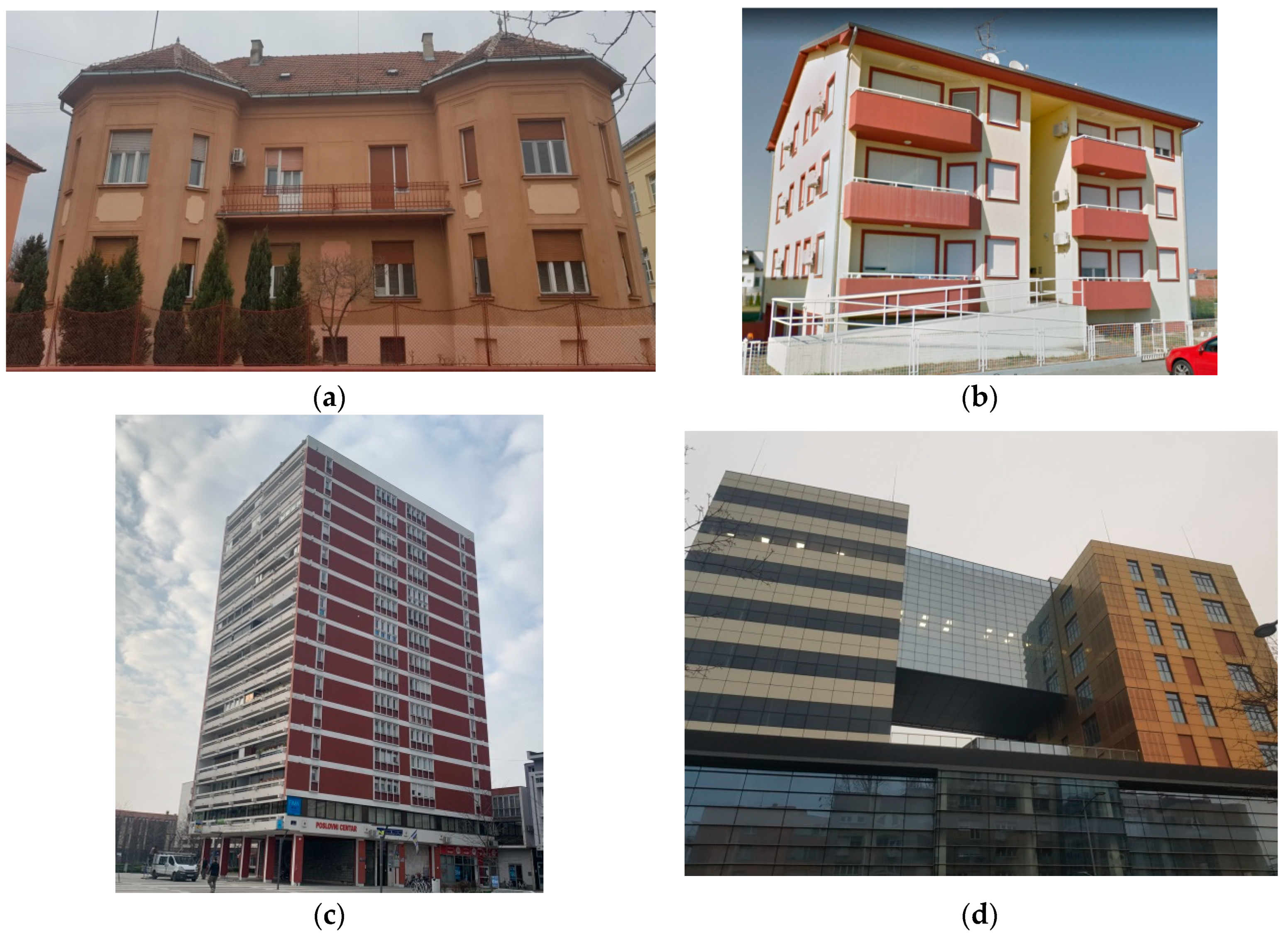
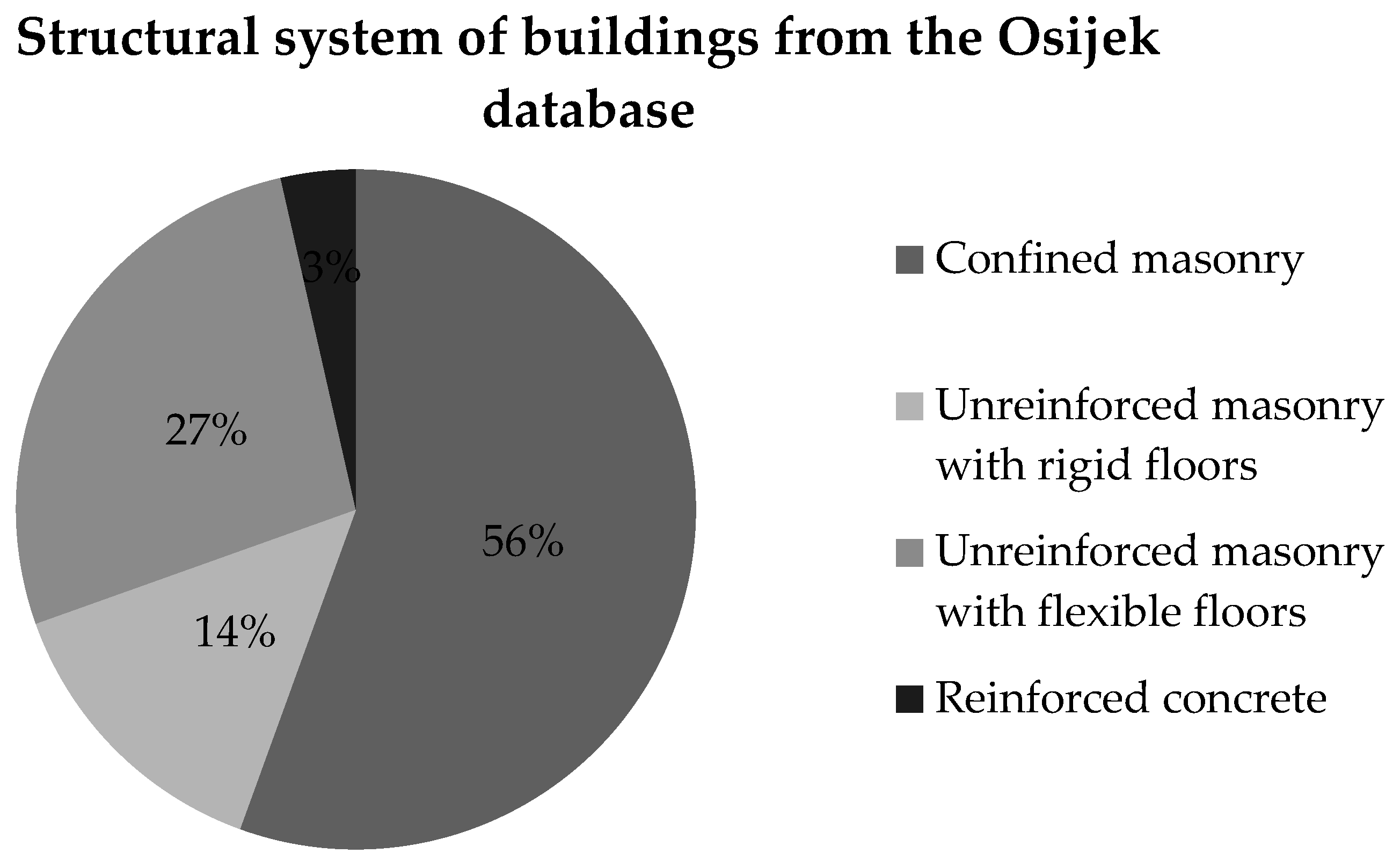
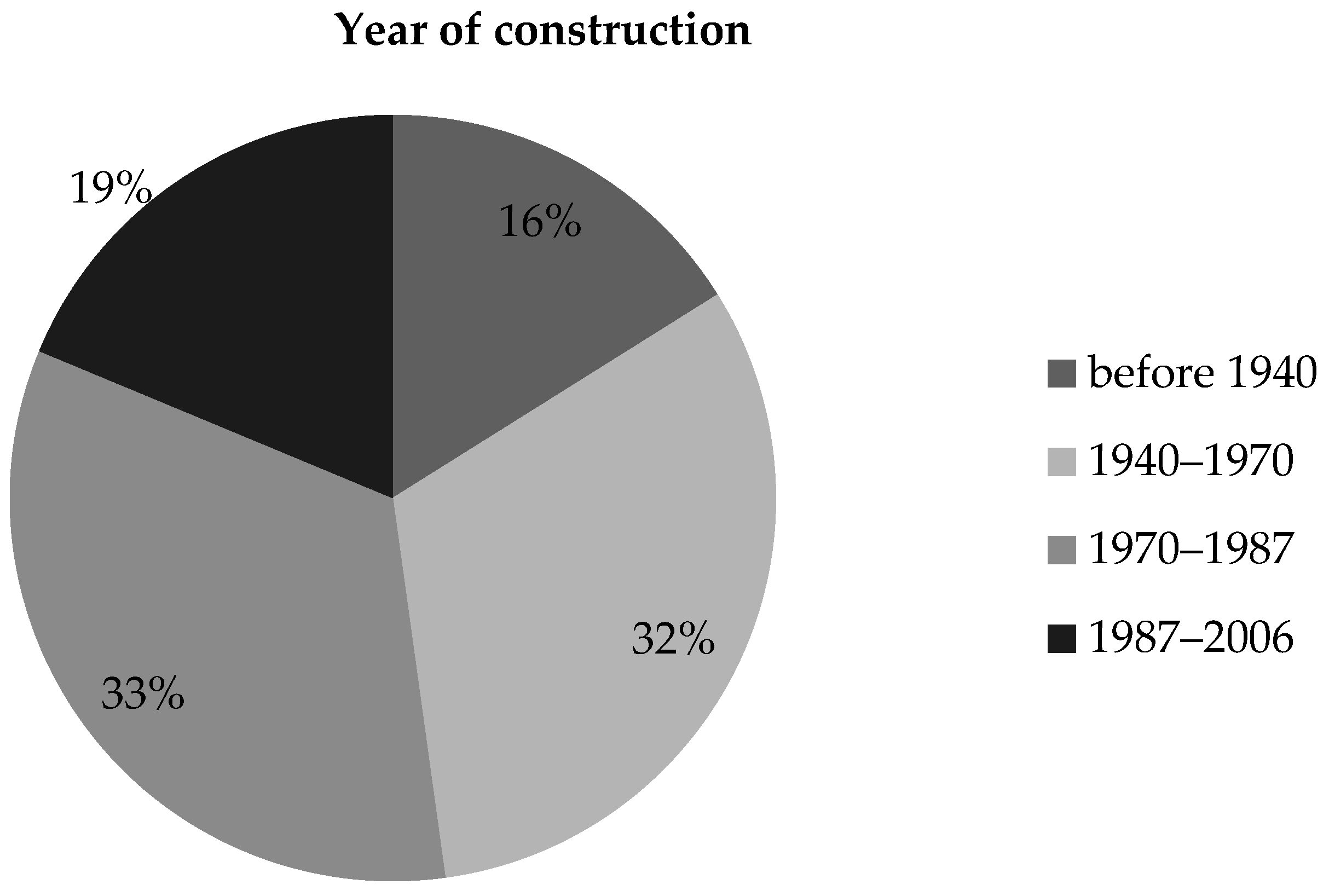
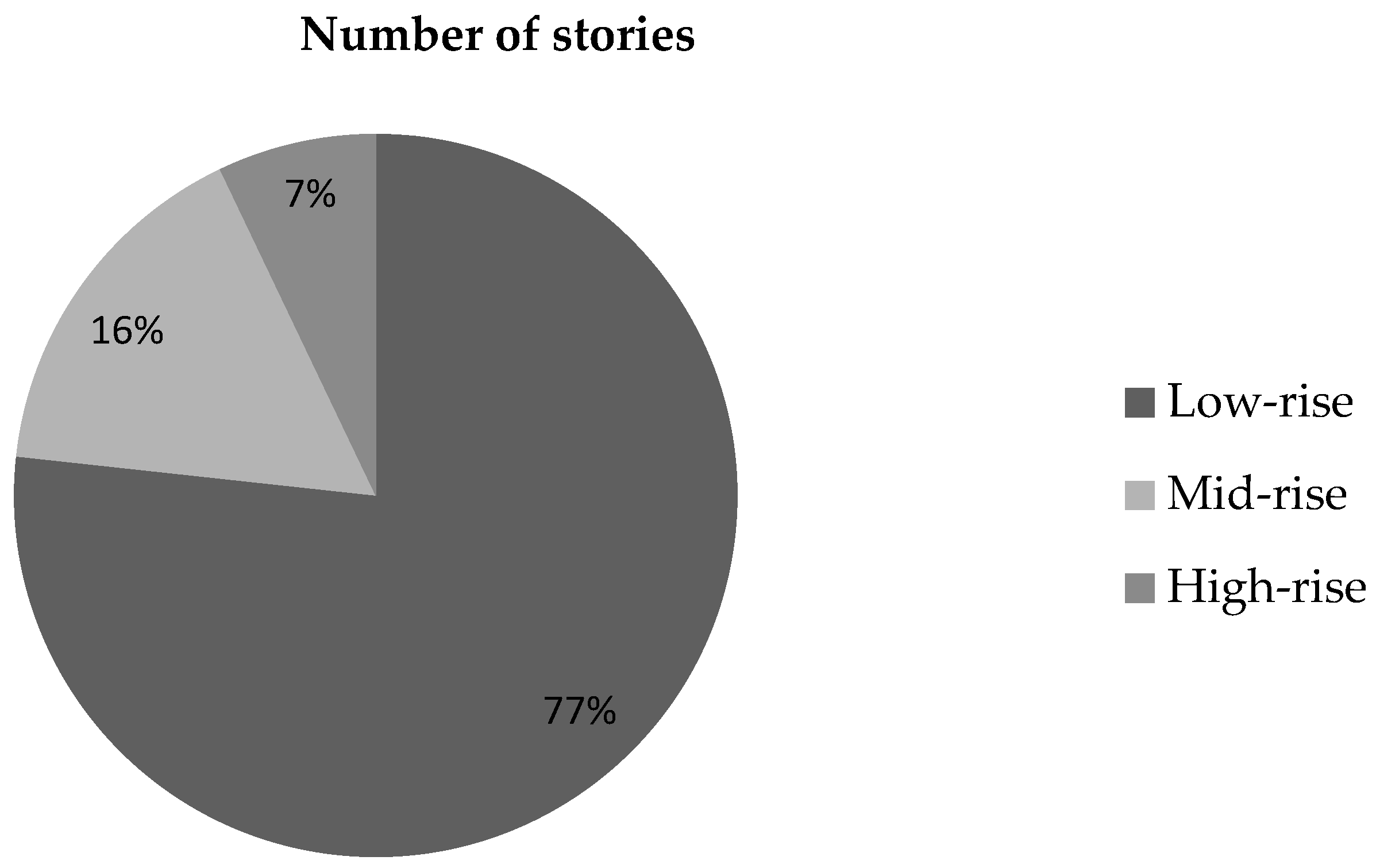
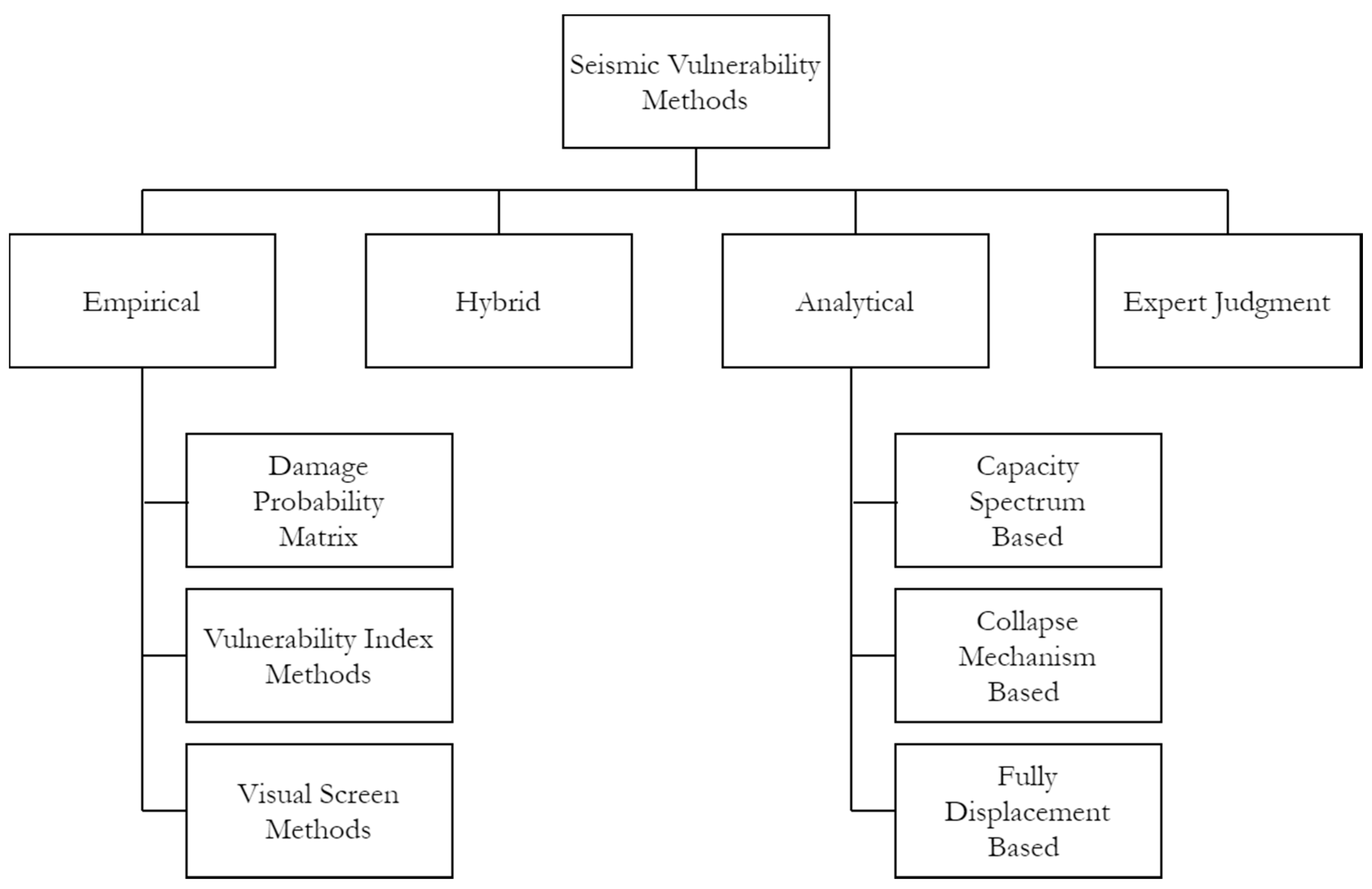
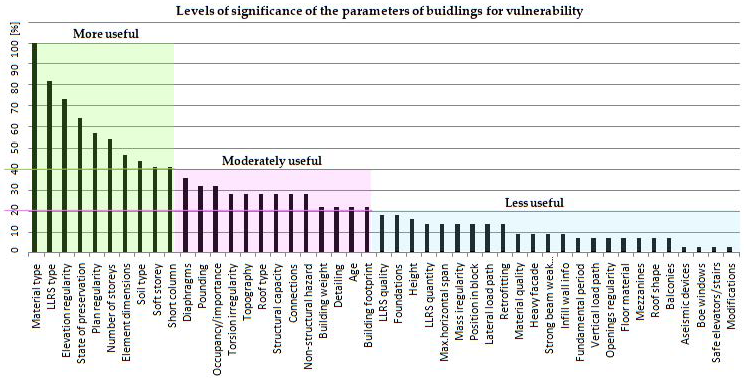
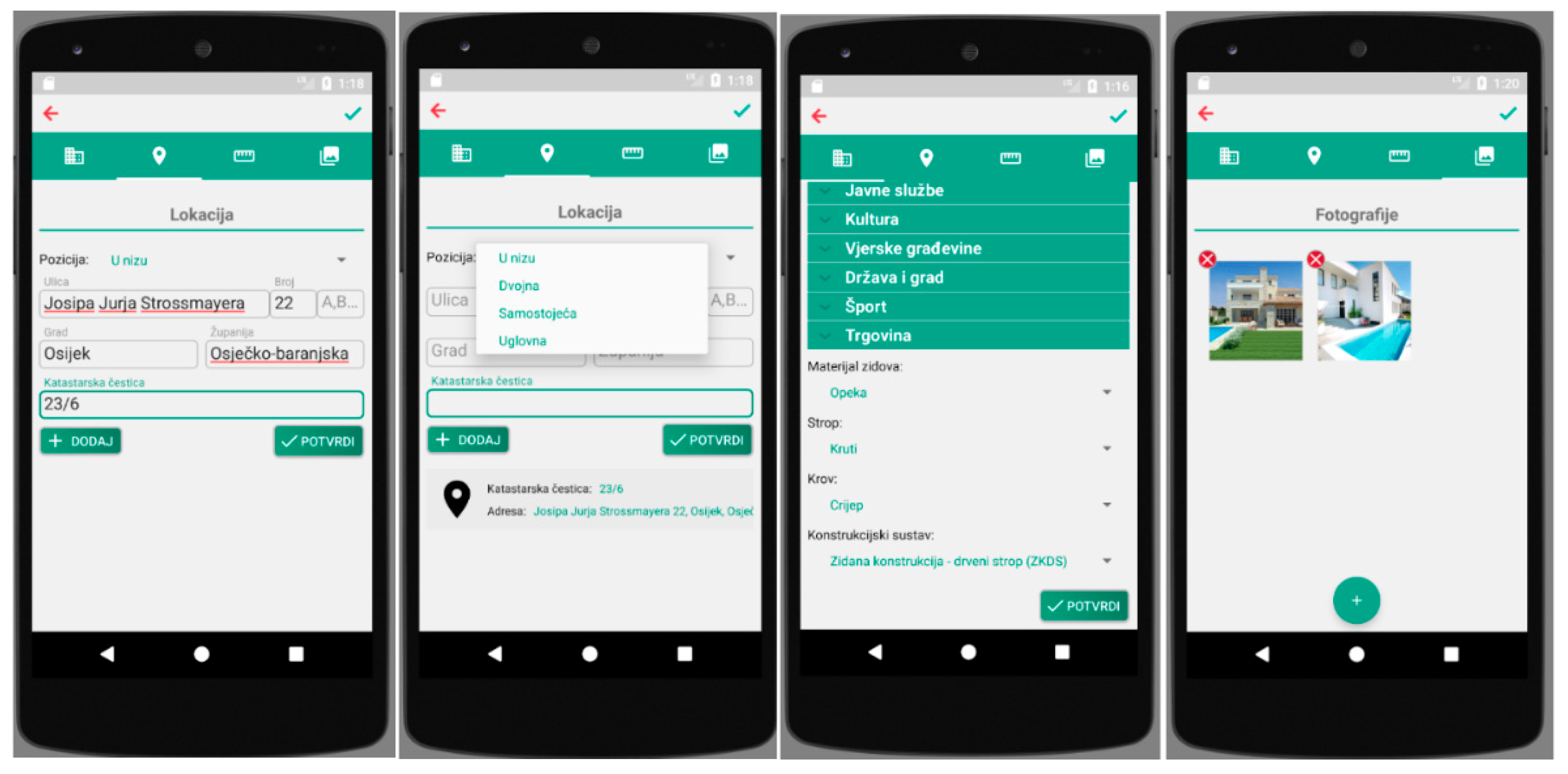
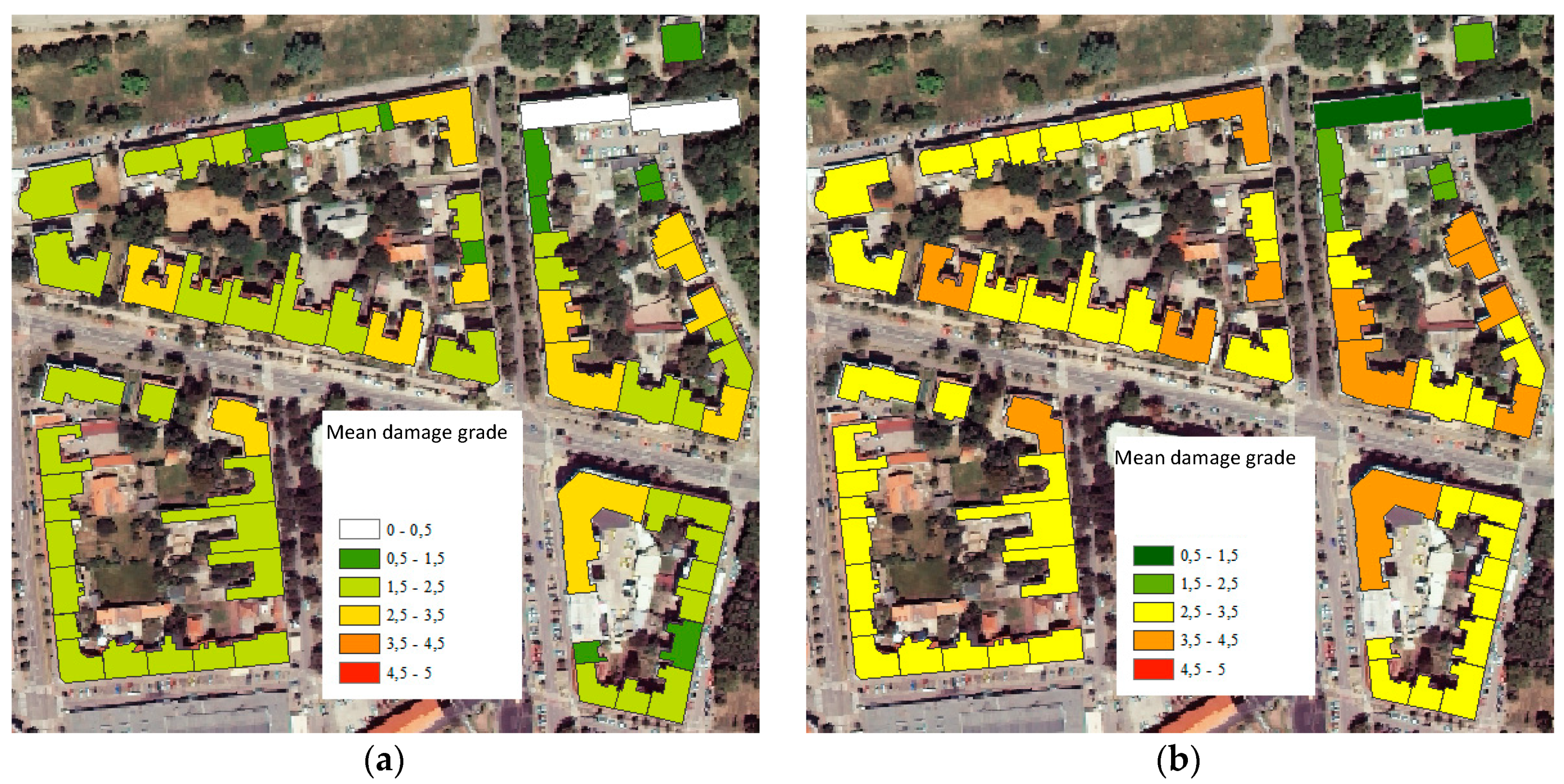
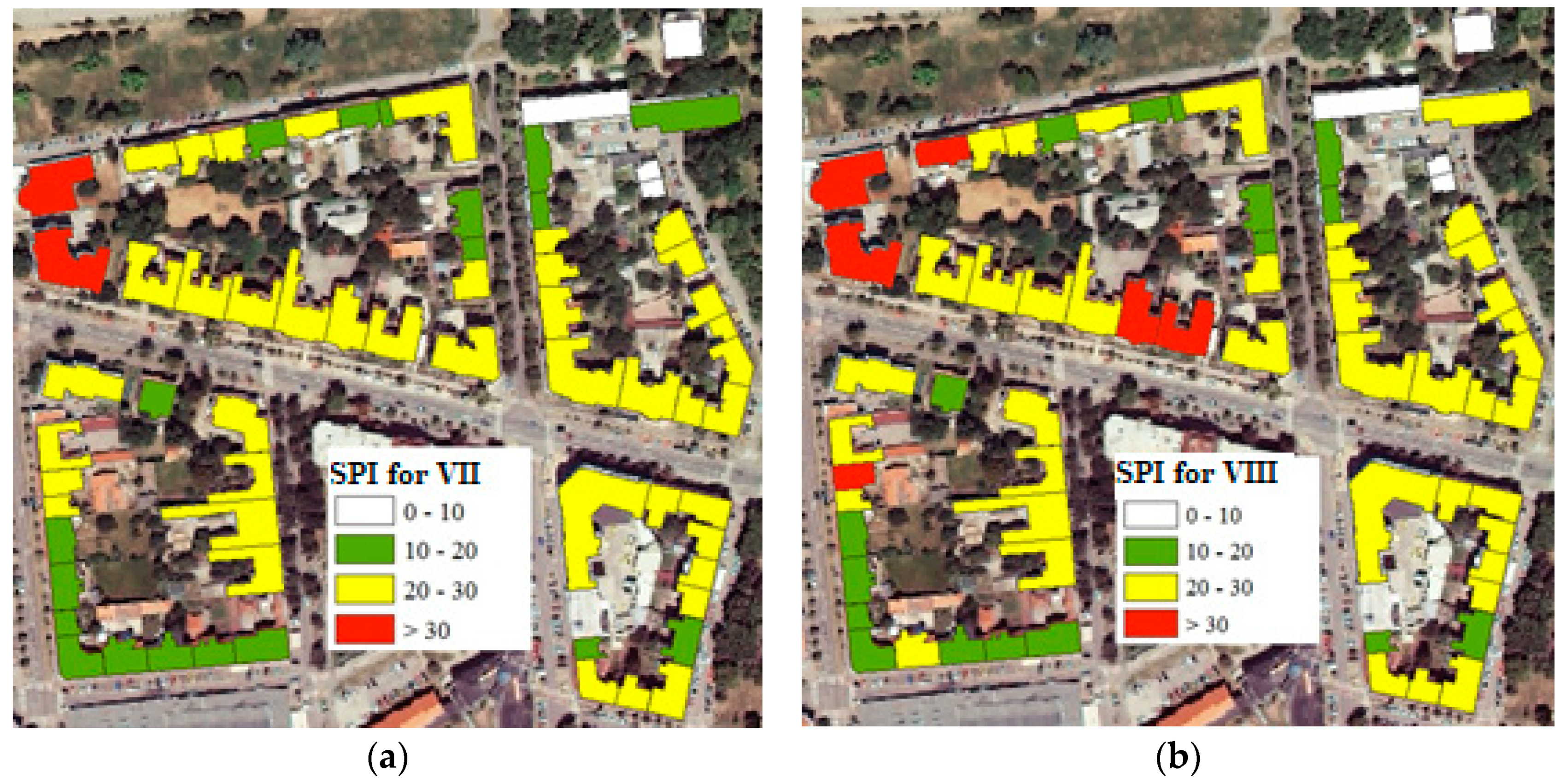
| City Name | 1950 | 1982 | 1990 | |||||
|---|---|---|---|---|---|---|---|---|
| 50 yrs. | 100 yrs. | 200 yrs. | 500 yrs. | 1000 yrs. | 10,000 yrs. | |||
| Zagreb | VIII–IX | VIII | VII | VII–VIII | VIII | VIII–IX | IX | IX |
| Rijeka | IX | VII | VI | VII–VIII | VIII | VIII | VIII–IX | IX |
| Split | VII | VI | VII | VII | VII | VIII | VIII | VIII |
| Osijek | VIII | VII | VI | VII | VII | VIII | VIII | VIII |
| Zadar | IX | VIII | VI | VII | VII | VIII | VIII | VIII |
| City Name | 1990 | 2011 | ||||
|---|---|---|---|---|---|---|
| 100 yrs. | 500 yrs. | Tr = 95 yrs. | Tr = 475 yrs. | |||
| Rock | Soil | Rock | Soil | |||
| Zagreb | 0.081–0.199 | 0.159–0.388 | 0.12–0.14 | 0.168–0.196 | 0.22–0.26 | 0.308–0.364 |
| Rijeka | 0.081–0.199 | 0.159–0.199 | 0.1 | 0.14 | 0.18–0.20 | 0.252–0.28 |
| Split | 0.081–0.102 | 0.159–0.199 | 0.12 | 0.168 | 0.22 | 0.308 |
| Osijek | 0.081–0.102 | 0.159–0.199 | 0.04–0.06 | 0.072–0.108 | 0.10–0.12 | 0.18–0.216 |
| Zadar | 0.081–0.102 | 0.159–0.199 | 0.08 | 0.112 | 0.18 | 0.252 |
| Period of Construction | Number | Percentage (%) |
|---|---|---|
| built before 1919 | 112,217 | 7.5 |
| built between 1919–1945 | 84,963 | 5.7 |
| built between 1946–1960 | 138,858 | 9.3 |
| built between 1961–1970 | 288,563 | 19.3 |
| built between 1971–1980 | 325,203 | 21.7 |
| built between 1981–1990 | 247,084 | 16.5 |
| built between 1991–2000 | 129,687 | 8.7 |
| built between 2001–2005 | 70,463 | 4.7 |
| built from 2006 | 73,072 | 4.9 |
| unknown | 24,640 | 1.6 |
| unfinished | 1808 | 0.1 |
| total | 1,496,558 | 100 |
| Age Distribution | before 1948 | 1948–1964 | 1964–1981 | 1981–2005 | 2005–2012 | 2010–Today |
|---|---|---|---|---|---|---|
| Seismic regulation (design standards) | - | - | 1st earthquake design regulation 1 | Regulation 1981 [18] | Pre-standards | Eurocode 8 [22] |
| The common type of construction | Stone and brick masonry buildings with wooden floors | Brick masonry with reinforced concrete floors | Masonry with RC floors (houses), confined masonry (residential buildings), and pre-code RC frames | Reinforced concrete buildings, confined masonry buildings | ||
| Number of Dwellings | Area in m2 | ||
|---|---|---|---|
| Osjecko-Baranjska County | 138,252 | 11,054,777 | |
| Osijek | 51,123 | 3,853,094 | |
| Method | Disadvantages |
|---|---|
| Empirical | - specific to particular seismo—tectonic, geotechnical, and built environments - errors in classification of building damages - intensity—uncertainty caused by subjectivity and discrete scale - lack of data for larger, rarer earthquakes - available databases capturing earthquake damage data may be incomplete or of poor quality - unable to account for specific structural details and the strengthening of buildings - Damage probability matrices (—based primarily on the observations of damages during past earthquakes may sometimes not be applicable for the prediction of damages during future seismic events. - practices of building construction often change significantly after disastrous earthquakes—the performance of new buildings cannot be then represented by existing probability matrices - vulnerability classes are defined for different building typologies based only on the material used in construction and on the structural system (and in part on the particularities of earthquake-resistant design) while neglecting the height range (number of stories) |
| Analytical | - the significant computational effort is needed while there are limitations in modeling capabilities - involve assumptions that can cause significant discrepancies in results - variation in results, depending on the use of different modeling techniques, input data, and ways to assign characteristics to the model |
| Mean Damage Grade Intervals | Most Probable Damage State | EMS-98 Damage Grade |
|---|---|---|
| 0–0.5 | None | D0 |
| 0.5–1.5 | Slight | D1 (Grade 1) |
| 1.5–2.5 | Moderate | D2 (Grade 2) |
| 2.5–3.5 | Substantial to heavy | D3 (Grade 3) |
| 3.5–4.5 | Very heavy | D4 (Grade 4) |
| 4.5–5.0 | Destruction | D5 (Grade 5) |
© 2020 by the authors. Licensee MDPI, Basel, Switzerland. This article is an open access article distributed under the terms and conditions of the Creative Commons Attribution (CC BY) license (http://creativecommons.org/licenses/by/4.0/).
Share and Cite
Pavić, G.; Hadzima-Nyarko, M.; Bulajić, B. A Contribution to a UHS-Based Seismic Risk Assessment in Croatia—A Case Study for the City of Osijek. Sustainability 2020, 12, 1796. https://doi.org/10.3390/su12051796
Pavić G, Hadzima-Nyarko M, Bulajić B. A Contribution to a UHS-Based Seismic Risk Assessment in Croatia—A Case Study for the City of Osijek. Sustainability. 2020; 12(5):1796. https://doi.org/10.3390/su12051796
Chicago/Turabian StylePavić, Gordana, Marijana Hadzima-Nyarko, and Borko Bulajić. 2020. "A Contribution to a UHS-Based Seismic Risk Assessment in Croatia—A Case Study for the City of Osijek" Sustainability 12, no. 5: 1796. https://doi.org/10.3390/su12051796
APA StylePavić, G., Hadzima-Nyarko, M., & Bulajić, B. (2020). A Contribution to a UHS-Based Seismic Risk Assessment in Croatia—A Case Study for the City of Osijek. Sustainability, 12(5), 1796. https://doi.org/10.3390/su12051796







